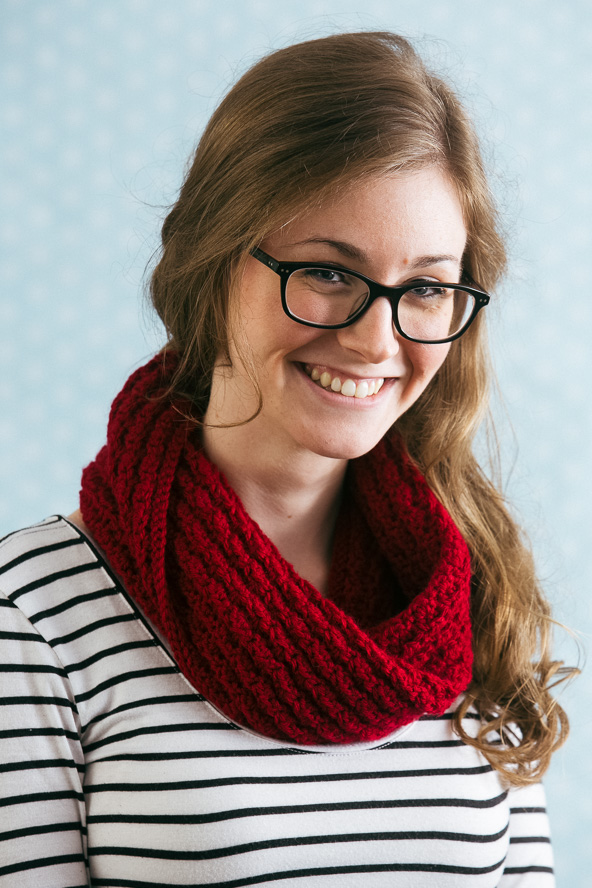
The Katahdin Cowl is the perfect accessory for all your outdoor winter activities. Named for Mt. Katahdin, the highest peak in the beautiful state of Maine, you’ll reach for this cowl again and again as you head outdoors in winter.
Skill Level: Easy
Size: Approximately 10” wide x 26” circumference, including twist
Gauge: 15 sts and 14 rows = 4” [10 cm] after spray blocking. Gauge is not critical for this project.
Materials
Yarn: Lion Brand Yarns Wool-Ease (80% acrylic, 20% wool; 197 yards [180 meters]/85 grams): #138 Cranberry (2 balls)
Hook: US size I/9 (5.5 mm) hook
Notions: Removable marker, tapestry needle, spray bottle (optional), measuring tape (optional)
Abbreviations
Bb (back bump): The horizontal lp on the back side of a ch st
Pm: Place marker
Blo: Back loop only
Pattern Notes
Katahdin Cowl is a true Möbius/infinity scarf, crocheted in the round from the center out. It is fascinating to watch while crocheting, as it increases on both edges in the same round.
It is crocheted in an easy to memorize, heavily textured stitch pattern, which gives an overall rustic striped effect.
Pattern size is easily adjustable, from a snug cowl to one that can be looped around the neck more than once. To adjust the size: use a multiple of 4 sts for the circumference and rep Rnd 2 for the width, before beginning Border.
Any weight yarn, with appropriate size hook, could be used. The cowl size and the yarn you choose will determine how much yarn you will need.
Piece is turned every round. When turning work, joins seem less noticeable if you turn clockwise.
To Spray Block (optional): Hang cowl over the narrow end of an ironing board with the twist hanging down and spritz with water. Pat out cowl to given measurements, rotating it as it dries. (Tip: Placing a fan on low speed to gently blow on cowl will help it to dry faster.)
Pattern
Cowl
Ch 136 (not too loosely), join with sl st in bb of first ch (being careful not to twist ch).
Rnd 1: Ch 1, sc in same place as joining (pm in unworked lps at base of sc just made), 2 hdc in bb of next ch, sk 2 chs, *sc in bb of next ch, 2 hdc in bb of next ch, sk 2 chs; rep from * around, up to first sc; flip first sc forward and now you will be working in the base of each st on opposite side of foundation ch as follows: sc blo in base of same first sc (where marker was placed, removing marker as you come to it), 2 hdc in base of next st, sk next 2 chs, **sc blo in base of next st, 2 hdc in base of next st, sk next 2 chs; rep from ** around, join with sl st in top of first sc. (68 sc, 136 hdc)
Rnd 2: Ch 1, turn, *sc blo in first hdc, 2 hdc in next hdc, sk next sc; rep from * around, join with sl st in first sc.
Rnds 3-17: Rep Rnd 2, 15 more times, or until desired width. Do not fasten off, but continue to Border rnd.
Border
Ch 1, turn, insert hook blo from front to back in first st, then insert hook blo from back to front in next st, yo and pull up lp, yo and draw through both lps on hook, *insert hook blo from front to back in last st worked into, then insert hook blo from back to front in next st, yo and pull up lp, yo and draw through both lps on hook; rep from * around, ending last st with insert hook blo from front to back in last st worked into, insert hook blo from back to front in first st worked into at beg of Border rnd, yo and pull up lp, yo and draw through both lps on hook, join with sl st in first st. (204 sts)
Fasten off.
Finishing
Weave in ends with tapestry needle. Spray Block to measurements, if desired (see Pattern Notes).


